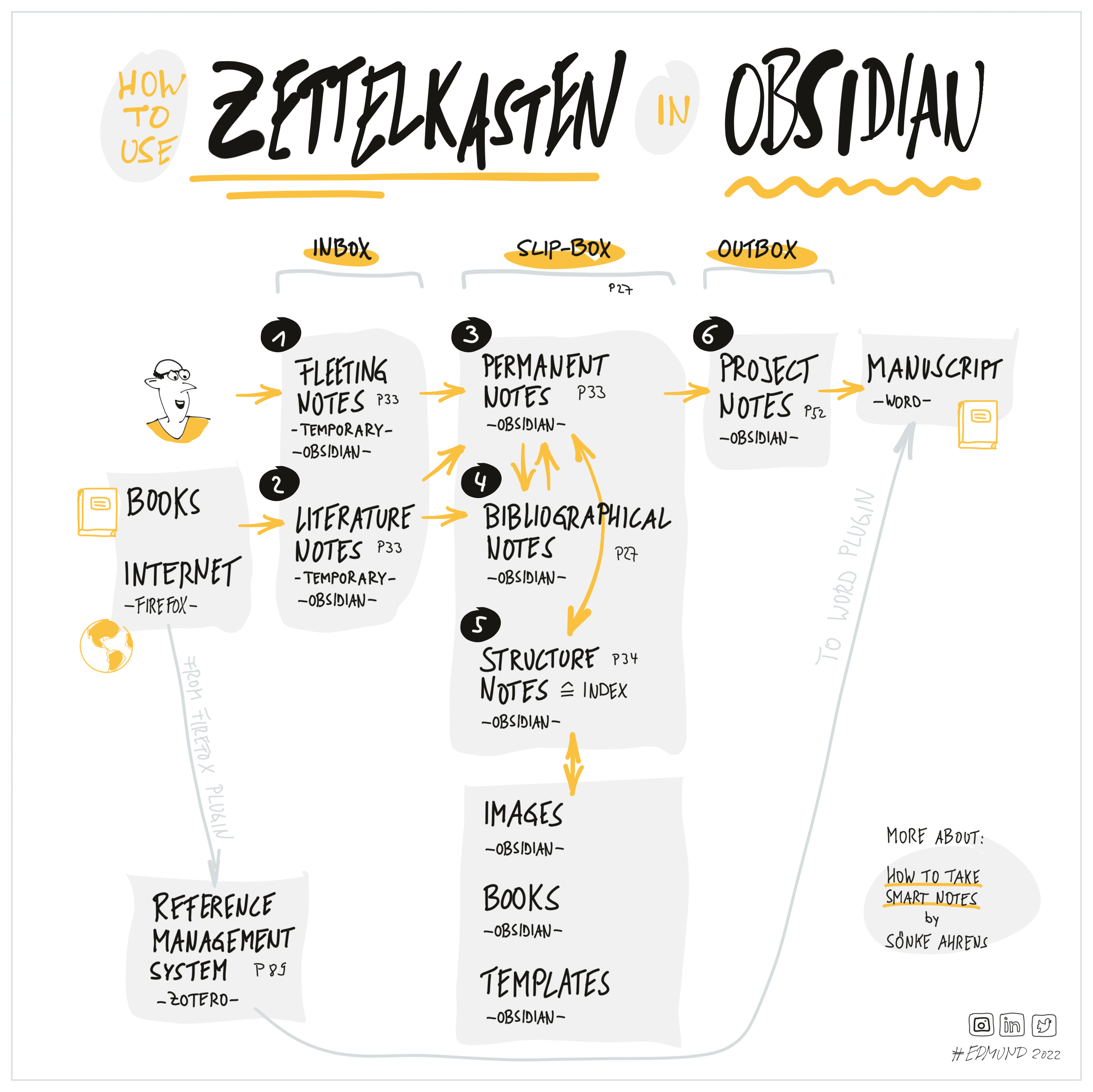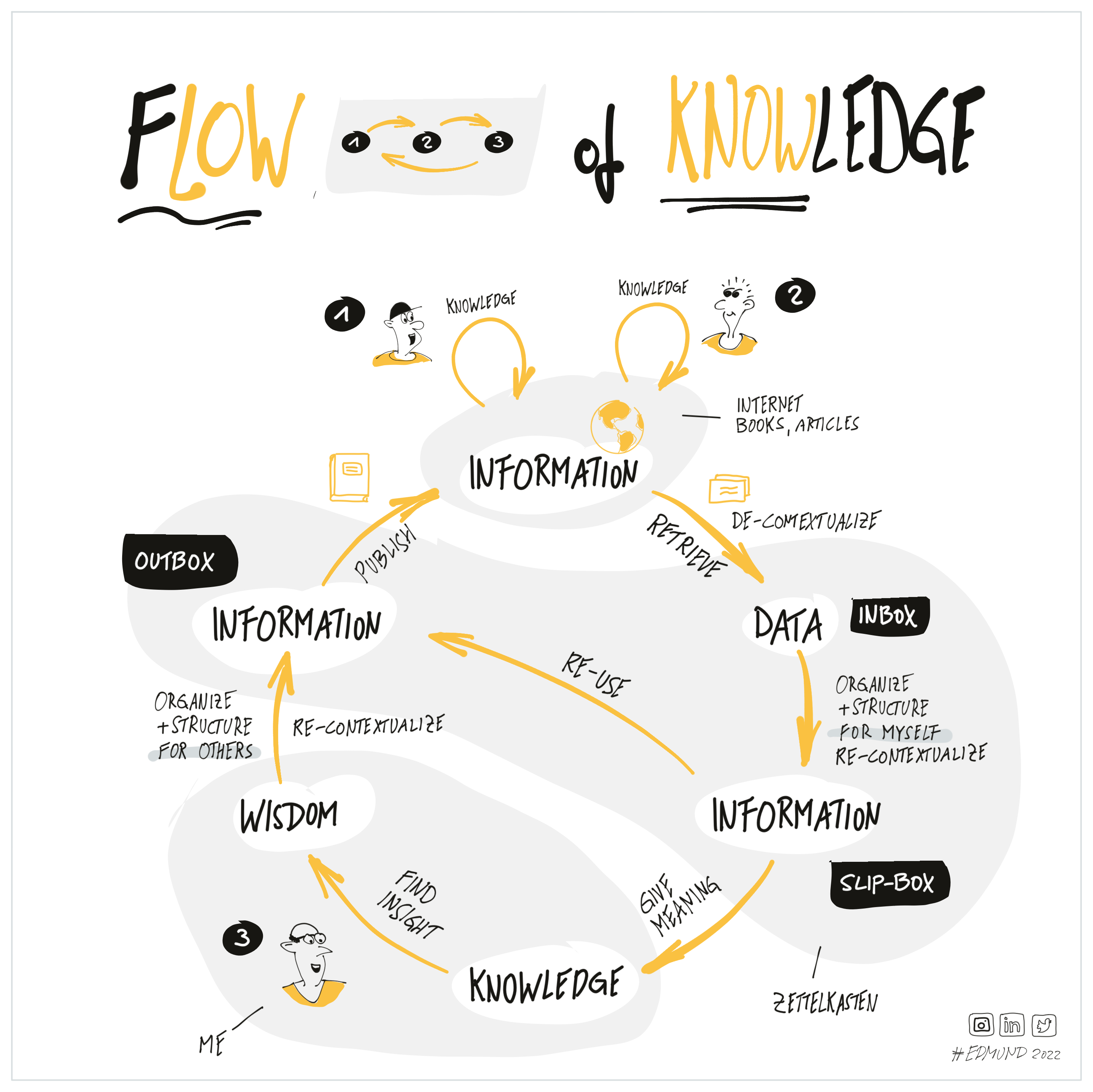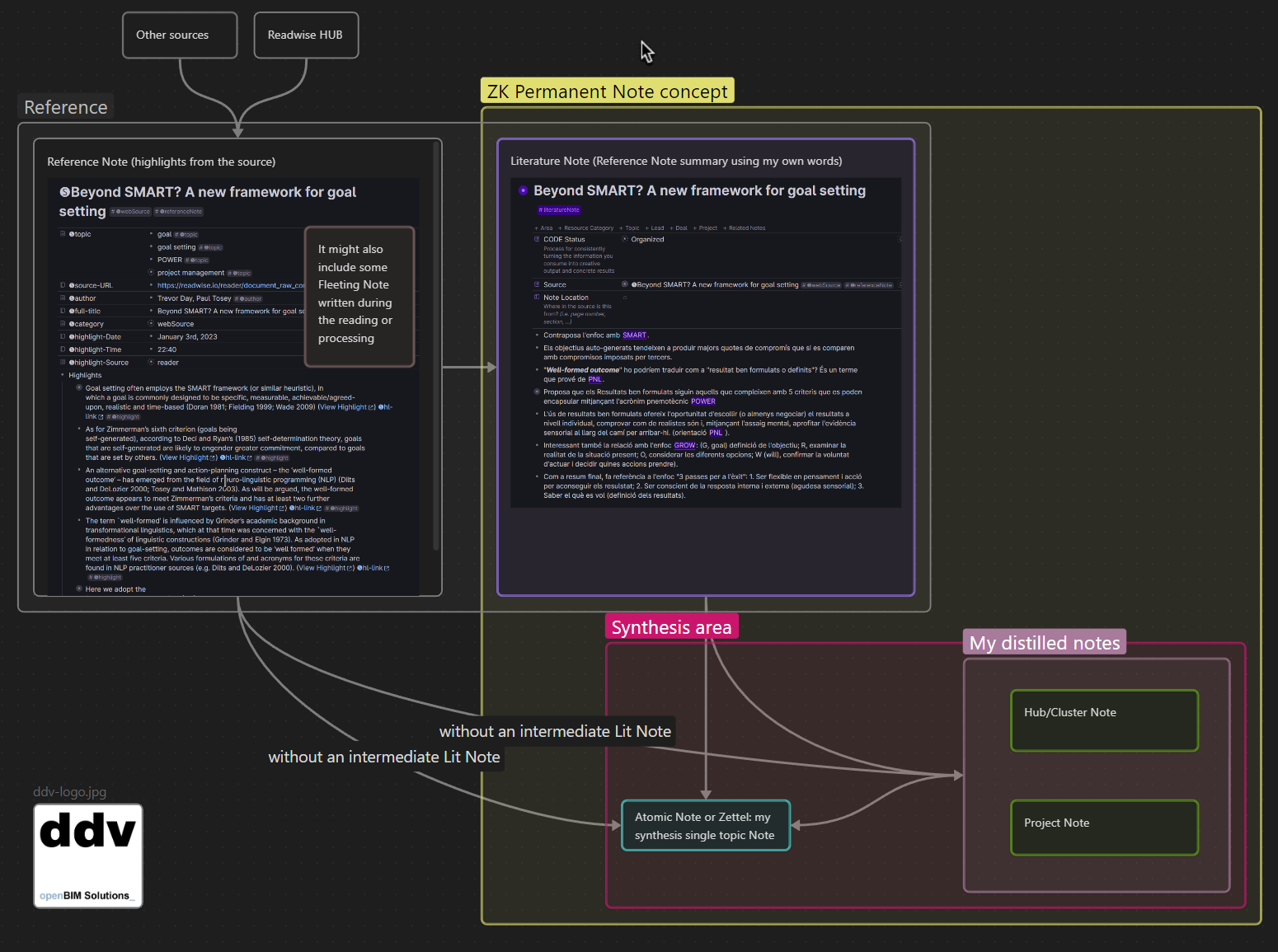What‘s your preferred workflow for using Zettelkasten?

I’ve just finished reading the amazing book from Sönke Ahrens about “How to take Smart Notes”(1). As a visual thinker and sketchnoter my first idea was to use this method to combine visual thinking with networked thinking. Taking smart notes is great, but taking smart sketchnotes would be even greater.
To summarize the content of a book like this within one sketchnote is not that easy. So I started to summarize one main aspect witch is important for a reader of Ahrens’ book to work with the Zettelkasten method. It’s the major workflow starting with filling the inbox till using the content of the growing slip-box to produce an output of higher value. I added the tools I’m using in this process and also the page numbers from the book as a reference for further reading and understanding the underlying method.
You are also working with Obsidian and Zettelkasten? Do you see any differences between your own and the workflow described by Sönke Ahrens?
—-
(1) Ahrens, Sönke. How to Take Smart Notes: One Simple Technique to Boost Writing, Learning and Thinking, 2022.
Edmund Gröpl
100% organic thinking. Less than 5% AI-generated ideas.
Howdy, Stranger!

Comments
Hi Edmund, thank you very much for making this workflow available. It makes it easier to understand the whole process. I started making a ppt to consolidate my Sönke's reading, but your art is impressive for the purpose of ready implementing learnings from the book. Warm regards,
Your style is awesome! I think it is very good overview for a beginner since beginner tend to think on the level of the notes.
Progression in one's understanding leads to a change in the perception. Not the flow of notes is longer the mode of thinking but the actual flow of knowledge, truth, mapping etc.
So, my question to you is: How would you re-sketch your workflow if you change the above decribed change of perspective?
I am a Zettler
“The flow of knowledge” sounds great. But I need some help to understand your concept. Do you have an example for me that makes it easy to follow your thoughts?!
Edmund Gröpl
100% organic thinking. Less than 5% AI-generated ideas.
Mh. I am hesitating to just post my own chart because I don't want to nudge you in any direction.
An example would perhaps be something like that: I see books as a stock of contextualised building block of knowledge. My job is to de-contextualise (from the book) and then re-contextualise in my Zettelkasten. If the building block is has an empirical foundation I imagine a flow of truth through the events of the experiment, interpretation etc. into what I am claiming within my Zettelkasten. Going to the primary source would be similar to cutting an intermediary from the flow of truth.
I am a Zettler
Here‘s my answer in a Sketchnote:
How many words would you need to describe this workflow in a perfect note for your own slip-box?
Edmund Gröpl
100% organic thinking. Less than 5% AI-generated ideas.
@Edmund Very nice - one can grasp the concepts quickly, without needing pages of explanation
Thank you - What’s your preferred style for note taking? Are you using visual notes as well?
Edmund Gröpl
100% organic thinking. Less than 5% AI-generated ideas.
My workflow
(draft)
GitHub. Erdős #2. Problems worthy of attack / prove their worth by hitting back. -- Piet Hein. Alter ego: Erel Dogg (not the first). CC BY-SA 4.0.
This looks awesome! I Wouldn't describe such a workflow in one note. Rather I'd come up with my own imagery and create a link for each step of the process to a note and describe there.
This is my own image (which looks way less happy..)
I am a Zettler
Please excuse what has turned into a very long answer to your short question
Currently, I don't use visual notes much (although I did earlier in my life, when I was at university, studying engineering, and then early in my working career, when there was still so much to learn).
My approach to note-taking has evolved over 10 years of "practise" in university and then another 40 years of note-taking at work and in my personal life. I was an avid note-taker for many years before discovering ZK.
First - I have always taken what Ahrens calls "fleeting" notes, in a handwritten format. For many years, they were on paper (using a "Cornell Notes" approach), and were stored by general subject matter or by source in various binders. Later (~5 years ago) I progress to using an iPad + Apple Pen in Goodnotes (still handwritten, in a "Cornell Notes" format).
These notes could be based on what I hear or what I read; it doesn't matter. I started just trying to capture everything I heard, then evolved to capturing only what I thought was important. Once I've finished the handwritten notes, I go through and highlight the most important elements, using 3 or 4 different colours. I have a colour sequence that I normally use to trace the development of various concepts or arguments in an original paper or lecture, from initial statement, through introduction of data and evolution of concept, to conclusion or hypothesis. Typically there are 3+ of these cycles in short articles or in chapters of books, and many more taking a book as a whole.
For some topics, there might be another step of tying various elements together in a mind map, but I do this only occasionally.
Until 2 years ago, that was as far as I got - writing and highlighting what one might refer to as "fleeting notes", although at the time I just thought of them as notes. I would refer to these notes, or at least to the highlighted sequences, at first often and then with decreasing frequency as they became a part of my working knowledge.
Then, 2 years ago, I discovered ZK, which changed my thinking about the value of notes and what to do with them entirely.
My practise up to the point of capturing and highlighting fleeting notes has not changed, but there are a few more steps to process my fleeting notes and get them into a ZK. These are the extra steps: in the margin of my fleeting notes, I select those items that I want to place into my ZK. Then, I create zettels by typing and using The Archive software. If I have original written material, I may refer back to it, but normally I just work off my handwritten notes. This is followed by the linking of zettels, adding of tags and creation of a few structure notes (I tend to be light on those). There are usually several processing cycles to get each zettel in decent shape and reasonably well linked to the rest of the ZK - I have a couple of tags I add to new zettels to help me manage that.
Finally, if I want to write an article or a report, I will peruse my ZK, having some general concept of the article in mind, and then select zettels that are relevant. I pull those into Scrivener, where they serve as the starting point and the inspiration for the full writing exercise, but just that. I find the writing itself requires additional creative thinking and composing (which is quite different than "atomizing" concepts). That process is not at all like just stringing a few zettels together.
For a few years, I experimented with bullet journalling and attempted to include visual notes. But I guess I'm not a very visual thinker, or at least, not a visual note-taker. I certainly did not produce the very artistic bullet journals that you can see on the internet. The exception are items of a technical / engineering nature, where graphs and figures are quite useful. But my days of taking heavy technical notes are pretty much past and my ZK contains very little technical material.
I looked back over your "flow of knowledge" diagram - I would say I include most of those steps somewhere in the process described above. Roughly, the right hand side of your diagram occurs in the taking and initial processing of the fleeting notes, the bottom part occurs when writing and connecting zettels, and the left hand side occurs during the actual writing of an article or report, outside of the ZK.
You see how not visual I am though - I prefer to describe my process in words rather than illustrate it with a diagram. Not that I can't appreciate a good diagram, I'm just not drawn to explaining myself in that manner.
I will have to amend the output of my own diagram. The output should be some form of writing--in my case. If a presentation, it would conform to the advice in Professor Patrick Henry Winston's popular MIT talk How to Speak. Dated perhaps, but I think it's effective.
GitHub. Erdős #2. Problems worthy of attack / prove their worth by hitting back. -- Piet Hein. Alter ego: Erel Dogg (not the first). CC BY-SA 4.0.
This is awesome. Did you draw that digitally? Or pend and ink?
Scott P. Scheper
Website | Twitter | Reddit | YouTube
Thanks. I drew this on a Wacom tablet with a stylus. Ordinarily I use Clip Studio Paint, but this time I was writing and drawing in Stylus Labs Write. This would be something like an under-drawing (really by this stage it's too late. A composition starts with basic shapes... .) The character is Glutanus, short for Homo Glutanus Cranium. I also have a Sentient Trashcan. Since Zettelkasteln are supposed to become communication partners, that might be another character.
GitHub. Erdős #2. Problems worthy of attack / prove their worth by hitting back. -- Piet Hein. Alter ego: Erel Dogg (not the first). CC BY-SA 4.0.
Are you interested in taking on illustration work? I could use your help 😁
Scott P. Scheper
Website | Twitter | Reddit | YouTube
And it’s worth reading 👍😀. Thank you for sharing your experience with lots of detailed description. For me it shows, that we all need a very personal variation of the Zettelkasten process. We always should adapt it to our personal style of thinking. That’s the way we could benefit most.
Edmund Gröpl
100% organic thinking. Less than 5% AI-generated ideas.
Great visual. It shows all the output generated by your process. It’s more than I’ve expected and for me an extra motivation to invest time in my own workflow.
Edmund Gröpl
100% organic thinking. Less than 5% AI-generated ideas.
Scott, thank you for asking. Unfortunately I'm swamped with work and other projects. -F
GitHub. Erdős #2. Problems worthy of attack / prove their worth by hitting back. -- Piet Hein. Alter ego: Erel Dogg (not the first). CC BY-SA 4.0.
The beauty is: If you read, atomise, associate, structure and integrate you'll get all the benefits that are out there.
I am a Zettler
I… tried hard to make a schemas as well. But a special guest came and then… Well, you see, the result is less more rigourous than yours and all. I am still learning to enhance my workflow, and I will take a look on this """""piece of art""""" to constate how much my workflow evolves.
I'd love to use Glutanus in my book for several illustrations. I can have it re-drawn by my fiancé. I'd of course credit you for the inspiration. Is this something you'd be open to? I think it would be a fun story to know this character came out of the zk.de forums! If you're open to this shoot me an email: scott@scottscheper.com
Scott P. Scheper
Website | Twitter | Reddit | YouTube
Hum hum.
@ZettelDistraction may I have your attention, please ?
As your personal devi… lawyer… I really need to talk here about your rights over Glutanus.
If you agree with @scottscheper enthousiastic and friendly proposal, the two of you would need a contract that will frame the utilization and condition of exploitation of your character, even for free if you prefer. Especially when money is implied somewhere else in the process. The redrawn thing does not change anything about your rights, especially if you are european.
It begins like a joke (which drops in strangely good time), but I am serious here. I don't know if the two of you have experience of illustration as a professional, but I have. You should take a moment to discuss conditions. You should read about intellectual rights and all in national or internation laws.
In France, we say "good accounts make good friends".
And I saw too many good ideas turning into catastrophic outcomes.
Thanks for the feedback, yes that's what we would figure out via email. Proper license and terms to make sure everyone's happy.
Scott P. Scheper
Website | Twitter | Reddit | YouTube
I am glad to read that May your possible collaboration be fruitful ! ♡
May your possible collaboration be fruitful ! ♡
I use a 13.3" XPPen Artist 13 (2nd Generation) screen drawing pad with clip studio and it's great. The screen is a nice texture and the pen feels nice in my hand. Sets up easy, but there is no portability, so desktop is where it will stay.
With Obsidian we now have a new plugin available called Canvas. It‘s a tool to create concept maps from notes of our Zettelkasten. My note shows the integration in my workflow.
Edmund Gröpl
100% organic thinking. Less than 5% AI-generated ideas.
@Edmund, in my humble opinion, this is the best, most concise illustration of Zettelkasten I’ve seen/found anywhere/anytime! Thank you!
Edmund Gröpl
100% organic thinking. Less than 5% AI-generated ideas.
This guy cracks me up
Author at Zettelkasten.de • https://christiantietze.de/
Do you have an established process for publishing out of your Zettelkasten? I’ve started a book project last year, but with Obsidian Canvas, I mentioned above, it will be my first book completely based on my Obsidian Zettelkasten.
Can you tell me something about typical pitfalls to avoid? Some valuable hints for a beginner?
Edmund Gröpl
100% organic thinking. Less than 5% AI-generated ideas.
I've had a related workflow-based concern, which I want to share with you in this thread about atomicity I had with Bob Doto:
https://www.reddit.com/r/Zettelkasten/comments/10o4yy1/atomicity_in_literature_notes/
Here is my current workflow:

David Delgado Vendrell
www.daviddelgado.cat